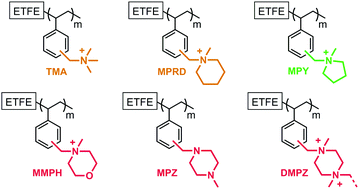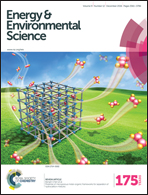High performance aliphatic-heterocyclic benzyl-quaternary ammonium radiation-grafted anion-exchange membranes†
Abstract
Anion-exchange membranes (AEM) containing saturated-heterocyclic benzyl-quaternary ammonium (QA) groups synthesised by radiation-grafting onto poly(ethylene-co-tetrafluoroethylene) (ETFE) films are reported. The relative properties of these AEMs are compared with the benchmark radiation-grafted ETFE-g-poly(vinylbenzyltrimethylammonium) AEM. Two AEMs containing heterocyclic-QA head groups were down-selected with higher relative stabilities in aqueous KOH (1 mol dm−3) at 80 °C (compared to the benchmark): these 100 μm thick (fully hydrated) ETFE-g-poly(vinylbenzyl-N-methylpiperidinium)- and ETFE-g-poly(vinylbenzyl-N-methylpyrrolidinium)-based AEMs had as-synthesised ion-exchange capacities (IEC) of 1.64 and 1.66 mmol g−1, respectively, which reduced to 1.36 mmol dm−3 (ca. 17–18% loss of IEC) after alkali ageing (the benchmark AEM showed 30% loss of IEC under the same conditions). These down-selected AEMs exhibited as-synthesised Cl− ion conductivities of 49 and 52 mS cm−1, respectively, at 90 °C in a 95% relative humidity atmosphere, while the OH− forms exhibited conductivities of 138 and 159 mS cm−1, respectively, at 80 °C in a 95% relative humidity atmosphere. The ETFE-g-poly(vinylbenzyl-N-methylpyrrolidinium)-based AEM produced the highest performances when tested as catalyst coated membranes in H2/O2 alkaline polymer electrolyte fuel cells at 60 °C with PtRu/C anodes, Pt/C cathodes, and a polysulfone ionomer: the 100 μm thick variant (synthesised from 50 μm thick ETFE) yielded peak power densities of 800 and 630 mW cm−2 (with and without 0.1 MPa back pressurisation, respectively), while a 52 μm thick variant (synthesised from 25 μm thick ETFE) yielded 980 and 800 mW cm−2 under the same conditions. From these results, we make the recommendation that developers of AEMs, especially pendent benzyl-QA types, should consider the benzyl-N-methylpyrrolidinium head-group as an improvement to the current de facto benchmark benzyltrimethylammonium head-group.



 Please wait while we load your content...
Please wait while we load your content...